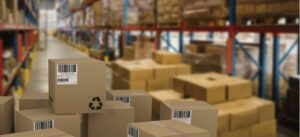Unprecedented Growth From 2021 Continues

Express and parcel services saw unprecedented growth in 2021, and the sector likely will continue to grow. Last year, we saw a surge in online consumer purchases using parcel services. Supply chain shortages also led some businesses to procure their short supply using parcel. As supply chain challenges recede and more retail businesses get back to “normal,” we may experience slower—but still substantial—growth in this segment. Q4 of 2021 saw the number of UPS packages grow 11%, and FedEx saw a 9% increase in package shipments from the previous year. The pandemic boom in package shipments slowed in the first quarter of 2022, FedEx domestic shipments remained flat, and UPS domestic shipments declined slightly. However, despite declining shipments, both FedEx and UPS saw substantial increases in profits.
On-Time Delivery Challenges
The sudden spike in package shipments, coupled with labor shortages, has created delivery challenges for both FedEx and UPS. Amazon set a high bar by delivering many of its shipments next day, which forced many retailers to follow suit and shift to next-day delivery. This fact, plus winter weather, further challenged on-time delivery. ShipMatrix data shows that FedEx’s on-time performance lagged behind UPS and the US Postal Service during the busy Q4 2021 holiday season, dropping below 90%. UPS and US Postal Service fared better, with higher than 90% on-time performance.
Largest Shipping Cost Increases for 2022
Both FedEx and UPS are making significant investments in their infrastructure to meet the expected continued growth in package shipments. Both companies increased their transportation costs by an average of 5.9% at the beginning of the year, which is the most considerable annual increase we have seen in at least a decade. Additionally, express fuel surcharges increased from 11.5% at the beginning of January to 21.5% at the beginning of April, which added another 10% to costs. Accessorial charges, fees not designated as transportation and fuel charges, such as residential charges and additional handling charges, are also increasing. Accessorial charges can be up to 25% of total costs, and are increasing at an even faster rate than transportation charges, with an annual increase of nearly 15%. Collectively, prices have increased by more than 20% in 1H-2022. While the number of shipments has remained relatively flat, rate hikes increased FedEx’s first quarter revenue by 10% and profit by 25%.

Ways to Decrease Small-Package Costs
There are several ways to reduce costs. Most companies solely focus on negotiating better discounts, but ERA has found that operation enhancements yield more considerable savings. Our approach of assessing clients’ operational needs and analyzing pricing options that meet those needs will generate substantial savings. Additionally, making informed operational adjustments will help further reduce accessorial and transportation charges. ERA has helped clients achieve more than a 15% reduction in express and parcel costs by combining these elements with expert rate renegotiation.
About the Author
Dileep Kulkarni is a Senior Principal Consultant with Expense Reduction Analysts (ERA). Based in Portland, Dileep focuses on unique customer needs to craft small package freight solutions that deliver saving while improving quality and service.

